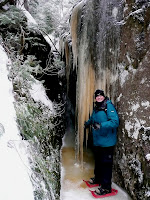 The stereotype of a French-accented fur trapper named Jacques, sporting a red plaid jacket, trudging feverishly through the snow on footwear resembling tennis rackets was my vision of snowshoeing.
The stereotype of a French-accented fur trapper named Jacques, sporting a red plaid jacket, trudging feverishly through the snow on footwear resembling tennis rackets was my vision of snowshoeing.The whole notion has a pioneering quality about it – even a romantic sentiment. With Christmas a few weeks away, it seemed like an appropriate time to try it out.
So it was with some amusement that we were introduced to modern-day snowshoes – slick looking, light-weight contraptions with rubber straps that adjust comfortably over one’s hiking boots with metal cleats on the underside acting as temporary anchors in the snow.
Arriving at the top of Mount Seymour with adjustments made to our footwear, all that was left to do was walk to the Dog Mountain Trail.

The trails had been blanketed in snow but after a week of freezing temperatures and no fresh snow, the ground was icy. This was no flat, wide trail – it was undulating, winding and quite narrow in parts.
My snowshoeing technique needed immediate honing. This meant trusting that the cleats on the underside of the snowshoe would hold me in place as I made my way forward.
After a kilometre we reached First Lake, frozen over, but with the tell-tale signs of other snowshoers and hikers.
Eventually we reached the rocky summit of Dog Mountain. Despite the wintry day, the view over the North Shore mountains and the City below was breathtaking - Stanley Park, Lions Gate Bridge and Point Grey clearly visible.
The buildings of the downtown core looking amazingly static. It was as though the city was devoid of people, and just a series of concrete statues.
The reality we knew was that down there in the metropolis it would be a cacophony of humanity in search of that perfect gift. Parking lots would be full to overflowing, people walking the streets with a glazed look on their faces. The joy of Christmas.
Up here on Dog Mountain the air was fresh, the vista below us a reminder of the world we had temporarily left behind.
Eating our lunch at 10:00 a.m. we greeted other snowshoers and their dogs and began the return trip. For some reason my trust of metal cleats had temporarily left my consciousness. I fell a few times on the downhill portions of the trail. Our leader reminded me to stand tall and look forward. I did, and eventually we returned to the ski hill and the parking lot.
With aching joints from the day’s activities I will admit to a slight mal de raquette – but oh the pure joy of being out there.
Jacques would have been proud.

.jpg)
+-+Copy.jpg)
.jpg)




















 What makes the Great Wall all the more spectacular is the way in which it was constructed on the ridges of mountains, rising up and down with the contours of the terrain. On the top of the Wall a road paved with square bricks is wide enough for six horses to go abreast. Watch towers, built at intervals of a few hundred yards line the Wall. These two-storey stone and brick structures were used as beacons and a means of communication to warn of an enemy’s advance – using smoke during daylight and fire at night.
What makes the Great Wall all the more spectacular is the way in which it was constructed on the ridges of mountains, rising up and down with the contours of the terrain. On the top of the Wall a road paved with square bricks is wide enough for six horses to go abreast. Watch towers, built at intervals of a few hundred yards line the Wall. These two-storey stone and brick structures were used as beacons and a means of communication to warn of an enemy’s advance – using smoke during daylight and fire at night.


















.jpg)
.jpg)
